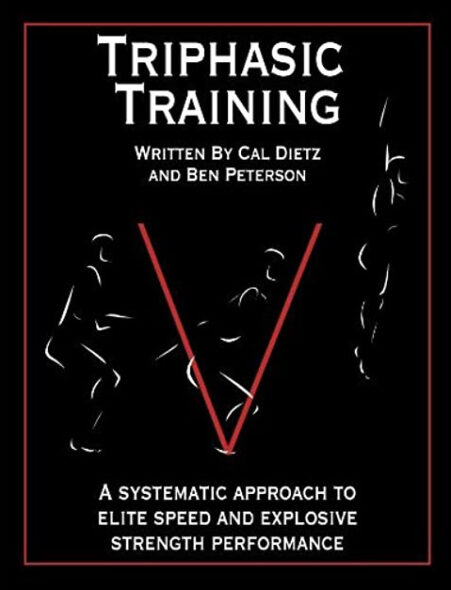STRENGTH SENSEI BOOKSHELF
TRIPHASIC TRAINING
Make a large pot of coffee, find a quiet room with good lighting and a comfortable chair, and put on your noise-canceling headphones. Now you’re ready to study Triphasic Training by Cal Dietz and Ben Peterson.
It’s not that this 390-page book is difficult to read with foot-long words that begin with the letter “Q,” but instead that it’s packed with so many training ideas that you can’t read it like a Harry Potter novel. It’s meant to be read like a college science textbook, and you’ll have to do the work.
To fully grasp the material, you should have a computer nearby. The authors have provided links to YouTube lectures and exercise demonstrations to support the material. In fact, before taking a deep dive into this book, you should check out some of the introductory video lectures by Dietz to get an overview of the material.

Triphasic training has developed a large following of fans, especially among college strength coaches. The following excerpts from this 5-star review on Amazon.com by Joey Powel of Praxis Athletics/CrossFit Prescott provides insight into why this system is so popular:
“If you are a Strength and Conditioning Coach and have not read this, you are missing the boat on what I have seen as one of the most clear and concise books on these matters out there…He proudly stands on the shoulders of those great coaches and researchers before him, to full credit, then astonishingly explains his concepts. Where he leaves others behind is that he painstakingly gives example after example and explanation after explanation for the phases of training…Mark my words, Coach Deitz will change the game like Verkhoshansky, Siff, Simmons, Issurin, Yessis, Bondarchuk, Bompa, etc…”
One takeaway from Triphasic training is that for optimal results, you need to control all loading parameters related to an exercise. In fact, the title comes from the idea that all dynamic movement consists of three types of muscular contractions: eccentric, isometric, and concentric. Sound familiar? In the late 80s, Australian strength coach Ian King introduced his 3-digit formula for exercise tempo in weightlifting, further expanded to four digits by Strength Sensei Charles R. Poliquin.

Those who follow the work of the Strength Sensei will find the format of Triphasic workouts a challenge. For example, the authors use a 4-digit tempo prescription presented with colons (so 4:2:1:1) rather than the Strength Sensei’s format without the colon (4211). However, the fourth number in their formula does not relate to the second isometric contraction in a lift. For example, a tempo of 0:1:0:10 represents a 1-second isometric pause in the disadvantageous leverage position, and the 10 represents the time between reps.
Rather than letting the reps determine the load, the authors use a percentage system based on 1-repetition maxes. However, they will give an intensity range. If you bench press 200 pounds, your intensity bracket might be 150-160 pounds. Mastering the basics of Excel would save a coach or athlete a lot of time working with these programs. Let’s move on.
The first section of Triphasic training begins as many exercise science textbooks do, and that’s with a review of Hans Seyle’s General Adaptation Syndrome. This is essential, and the training system is focused on the idea that the optimal amount and degrees of stress to the body are critical for improving athletic fitness. They expand on Selye’s work to present five of these crucial components of every program:
- High volume
- High intensity
- High frequency
- High expectations
- Overreaching
One area where Triphasic Training falls short (and this is a minor criticism) is in their discussion on weightlifting history. To give a real-world example of the importance of managing stress, the authors discuss the rise of the Bulgarian weightlifting team that upset the heavily favored Russian team in 1972.
Both teams won 3 gold medals, but Bulgaria won 3 silver to the Russians 1 silver and 1 bronze. However, it should be noted that in the 198-pound bodyweight class, the heavily favored Russian world record holder David Rigert missed all his snatches, leaving the door open for Bulgaria to win gold and silver. And in the 181-pound bodyweight class, two Russians favored to win gold and silver missed all their lifts. But a victory is a victory.
More importantly, the authors contend that the superiority of the Bulgarians at the time could be attributed to their greater volume (lifts per month) and training load. Good observation, but there were many other differences in the programs. First, the Bulgarians emphasized the competition lifts in their training more than the Russians, whereas as Russians used many auxiliary exercises, such as pulls. The Bulgarians also trained multiple times per day to improve the quality of their workouts, whereas the Russians often only trained once.
Those criticisms aside, Triphasic Training presents an extensive training system that covers not just all the loading parameters associated with strength and conditioning but long-term planning. And it goes beyond just theory, presenting detailed workouts of numerous sports, including a full year (52 weeks) football program. It lives up to its promise in the subtitle: A Systematic Approach to Elite Speed and Explosive Strength Performance.
Borrowing from business consultants Ken Blanchard and Sheldon Bowles, Triphasic training doesn’t have just satisfied customers, it has raving fans! Pick up a copy and see what has so many strength and conditioning coaches talking.
[You can purchase Triphasic Training: A Systematic Approach to Elite Speed and Explosive Strength Performance by Cal Dietz and Ben Peterson through Amazon.com.]
